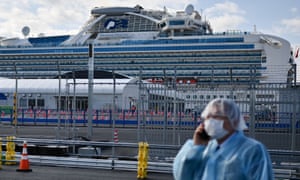Hundreds of passengers have begun leaving the stricken Diamond Princess in Japan after testing negative for the coronavirus, ending two weeks of quarantine that experts say failed to prevent the virus spreading onboard.
Japanese TV showed passengers – who spent quarantine largely confined to their cabins – leaving the ship on Wednesday morning to board waiting buses, while others left the pier in Yokohama, near Tokyo, by taxi.
Local health authorities said just in excess of 500 passengers were expected to disembark on Wednesday with another 2,500 to follow over the next two days. About half the passengers were Japanese, media reports said.
Those living or staying in Japan were given contact details in case they develop symptoms of Covid-19, which has killed more than 2,000 people in China and infected more than 74,000 others. Hundreds of infections have been reported in other countries, along with five deaths. Japan has 615 cases confirmed, including 542 on the Diamond Princess.
Members of Japan’s self-defence forces escorted some passengers, including an elderly man in a wheelchair who wore a face mask. Some of the people still on the ship waved from their cabin balconies as passengers disembarked below.
“I’m a bit concerned if I’m OK to get off the ship but it was getting very difficult physically,” a 77-year-old man, who got off with his wife, told Kyodo News. “For now we just want to celebrate.”
Others expressed joy at their new-found freedom.
Yardley Wong
(@yardley_wong)#day15 #disembark #COVID19 VICTORY! ???????? ? ? #HanginthereDiamondPrincess #coronavirus pic.twitter.com/pvD6fsEJ0U
People in Yokohama appeared supportive of the decision to allow the passengers out, despite fears that some could be infected. “I am sure those people onboard must be really worried. I hope they can go back to their normal life soon,” Isamu Habiro said. “As a Yokohama resident I don’t want them to be treated unfairly. I want to cheer for them.”
Only those who have tested negative and did not share cabins with infected passengers were being permitted to disembark, amid widening criticism of Japan’s handling of the ship’s quarantine.
Anyone who has had contact with an infected passenger will have to undergo 14 more days in quarantine. In addition the crew will begin a new quarantine when the last passenger has disembarked. The ship’s operator, Princess Cruises, said in a statement that 169 people who tested positive recently were still on the ship as they waited to be taken to hospital.
The Diamond Princess has proved a fertile breeding ground for the virus, with at least 542 positive cases diagnosed among the original 3,711 people on board – making the ship home to the largest cluster of infections outside mainland China. It has been moored in Yokohama since 3 February after it emerged that a passenger who disembarked in Hong Kong in late January had tested positive.

“NEGATIVE! Me, son, husband, mom and dad! Thank you Lord for protecting us … So emotional now,” tweeted Yardley Wong, a passenger from Hong Kong who has spent just over two weeks onboard with her six-year-old son.
Experts have raised concerns about allowing people from the cruise ship to board flights home or spread out into crowded cities such as Tokyo, saying there is a chance that secondary infections had occurred on the ship during its 14-day quarantine.
Kentaro Iwata, a specialist in infectious diseases at Kobe University hospital, who spent several hours on the luxury cruise liner on Tuesday, said he believed “fatigued” health officials were becoming complacent about the spread of the virus in Japan.
“There is a sense of complacency about the spread of the virus … that it is too late to do anything about it,” he said. “But we are still in the containment stage. There are small clusters of the virus in Japan, but people in other areas have all tested negative. There is no way that we should give up on this now.”
Iwata warned that some of the passengers leaving the Diamond Princess could turn out to be carrying the coronavirus and accused health officials of bungling the quarantine.
“It is a good idea to allow people to disembark because conditions on the ship are dangerous, but it is possible that some people who recently tested negative could turn out to be positive,” Iwata told the Guardian, adding that passengers cleared of the virus should continue to be closely monitored for another two weeks in case they develop symptoms.
“Certainly those who are due to leave should not be allowed to wander around freely. They have to be monitored so they can quickly receive medical treatment if they show symptoms.”
Iwata said he had been shocked by conditions on the ship. Experts in infection control were unable to take decisions without the approval of health ministry bureaucrats, he said. In addition the separation of green zones, where there was no evidence of the virus, and potentially infected red zones had not been properly enforced, with officials, crew, health experts and others “walking around” the ship. “It was completely chaotic,” he said.
Michael Ryan, head of the World Health Organization’s Health Emergencies Programme, said: “Clearly there has been more transmission than expected on the ship.” Japanese authorities, he added, were “taking the necessary public health measures with other countries to evacuate people and deal with the follow-up in a different way”.
Several countries including Britain, Hong Kong and Australia were organising chartered planes to bring back their citizens. Earlier on Wednesday South Korea flew six of its nationals plus a Japanese spouse to Seoul. They would be placed in isolation for 14 days, the Yonhap news agency said.
More than 300 Americans were flown home on Monday, although 14 of the passengers tested positive during the evacuation. The US Centres for Disease Control has told more than 100 Americans who chose to remain on the ship that they will not be allowed back into the country for at least two weeks after they disembark.
Other countries will require repatriated people to undergo another two weeks of quarantine after they return home.
Japan’s top government spokesman, Yoshihide Suga, defended the country’s handling of the quarantine. “In the beginning the United States expressed gratitude for the Japanese side. And there are many Americans who chose to stay on the ship,” Suga said.
Japanese officials said there was little evidence that Covid-19 tests could produce false negatives and noted that their quarantine policy had been endorsed by the WHO. They pointed to the hundreds of Japanese citizens evacuated from China, most of whom tested negative at the start of a quarantine and remained negative.
“As far as we know, once the test is negative they remain negative,” said Takaji Wakita, director general of Japan’s National Institute of Infectious Diseases.








